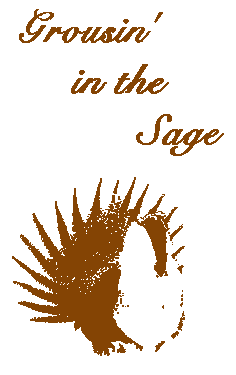






powered by SignMyGuestbook.com

| Newest
Older Previous Next Random Contact Profile Host |
blizzard warnings - 13:52 , 03 October 2013 heelerless - 21:32 , 18 August 2013 Red Coat Inn in Fort McLeod - 11:38 , 23 June 2013 rushing into the waters - 09:53 , 21 June 2013 choosing a spot - 17:43 , 27 April 2013 |
spiked
When I first saw it, I was surprised.

Dead and dying sagebrush, every direction I looked.
Of course, then I remembered. Remembered seeing the first dying plants on this route last August.
Poisoned.
And I remember the federal fellow telling about their plans to kill off 70 percent of the sagebrush up here on this high plateau, just off the Divide. For, literally, miles and miles of country.
Sagebrush that was near-ideal for nesting sage grouse. Just the right height, and maybe just a little too thick in some places. But the grouse were here, raising their broods every summer, so they apparently thought it was okay. In fact, radio work in the 80s had found hens bringing their chicks from 10-15 miles away to summer on this high, lush range.
But the rancher needed more grass for his cows. By God, if he bought a 2,000 cow ranch, it was going to have 2,000 cows on it, and not one less.
And this is a trick commonly done in these parts. Get rid of the sage, and grasses soon come in. Trading sage grouse, pronghorn, sage sparrows, Brewer's sparrows, and a host of other critters dependent upon sagebrush for an increase in someone's profit margin.
'Course, in this case, as a federal worker admitted to me, getting rid of the sage wasn't going to improve grass and forb densities at all. Here, those plants were already at a density higher than you could find in most places around. Problem is, the sagebrush is too tall and thick for the cows to get down and eat all that good herbaceous growth.
Which is probably why the grasses and forbs were doing so well in the first place.
But either way, the sage had to go. First plan called for a massive prescribed burn. Not a cool, spring burn that would wander through the sage making a meandering mixture of sage and open areas, which even the grouse would have enjoyed.
Nope, a huge, hot, fall burn that would have scorched the land in broad swaths of black. With the stated goal of removing 70 percent or more of the sage. And naturally, it would be the thickest sage with the densest undergrowth that would have burned. The best of the nesting habitat.
But getting the right weather conditions for a fire prescription is tricky. After two falls went by with no burn, they opted for the poisoning plan.
The land was "spiked". A chemical otherwise known as tebuthiuron. Applied from the air in little white, curly clay pellets that look so much the world like sage grouse turds. And any sagebrush (or most other shrubs) whose roots are touched by the chemical as it leaches into the ground, dies. For at least 10 years, in most places.
It's a touchy chemical to apply. A little bit more clay than expected in the soil, and the chemical gets soaked up and less sage dies. Change the soil pH just a little, and the chemical leaches farther and faster, and a lot of sage dies. The bigger the plants, the more extensive their roots, and the greater the kill. And since it continues to kill for at least 10 years, the first young sagebrush plants to shoot up in recovery are often killed, too.
The University did similar treatments on the outfit's land just to the south some years ago. But there they aimed for a 50 percent kill, the recommended maximum in sage grouse country, and actually seemed to get a little bit less. And the grasses and forbs responded, and the grouse appear to have survived, if not thrived.
That area certainly looks better than a burn.
But here? Well, it looks like they got their 70 percent, if not a little bit more.

It was sickening to look at. To drive through for hours.
I had to keep reminding myself to look at the little flashes of blue-green mixed in with the grey. The few sagebrush plants that might survive, to seed another generation in ten years' time.
Most of those survivors wouldn't be there if the land was blackened from flame.
This is better, I told myself.
This is better.
I'm sure.
I'm sure...